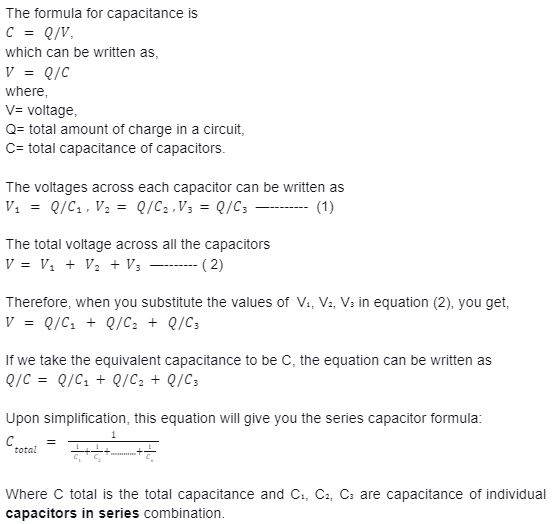Many components in the electric circuit are responsible for steady current flow. The capacitor is one of the essential parts of the electric circuit, which holds the current and stores it to balance the electric charge in the circuit. This component stores the electrical energy in an electric charge and produces the potential difference or static voltage between the electrical plates.The capacitor is a two-terminal device that possesses two electrical conductors at a certain distance. The ability to store the electric charge between the capacitor is its capacitance.
What are the applications of capacitors?
Capacitors have varied applications, such as signal processing devices, filters, engine starters or energy storage systems. They are used in both electrical and electronic fields.
- The primary function of a capacitor is to store electrical energy. Therefore, capacitors can be used whenever additional power is needed, i.e. in case of temporary power shortages.
- Capacitors can also be used as sensors. Measuring the mechanical strain, humidity and fuel level are some of the applications where capacitors are widely used.
- Timing capacitors are used in loudspeaker systems or LEDs to give regular beeping or flashing lights respectively. Here, the capacitors are used in time-dependent circuits.
Capacitors in different combinations
Multiple capacitors are often connected in several different combinations to obtain varying levels of capacitance. These complex combinations of capacitors can be segregated into two basic categories.
- Series Combination
- Parallel Combination
The total capacitance of capacitors in series and parallel combinations depends not only on how they are connected but also on the individual capacitors.
This article will discuss capacitors in series and how they function.
Capacitors in series:
In various applications, multiple capacitors connected in different combinations serve varied requirements. These multiple connected capacitors act as a single capacitor whose output depends on how they are connected. The total capacitance of this combination is also based on the performance of the individual capacitors.
In the case of capacitors in series, the resultant capacitance is equal to the entire summation of space between each capacitor plate.
In this type of combination, the total capacitance is less than the individual capacitances of the capacitors in series.
One, two or several capacitors may be connected in a series combination. But the overall impact is that of the single capacitor or equivalent, which has the total spacing between the plates of each capacitor. The capacitance in the capacitors in series combination decreases with the increased plate spacing, with all the other factors staying unchanged.
Analysis of capacitors in series combination:
In many cases, it is required to connect multiple capacitors in series to create a functional block.
This functional block is connected to a source of voltage. Each capacitor in the functional block stores the same amount of charge. It implies that the total charge quantity is equally distributed among all the capacitors. Note that each of these capacitors may have varied capacitance. If Q is taken to be the total amount of charge in the functional block, then the amount of charge in each capacitor is
Now, let’s explain why the individual capacitor charges are mutually the same or equal and why the charges of individual capacitors in series are equal to the total charge of the complete functional block.
Let’s assume that the capacitors in series are uncharged at a particular time. Then, when you apply a voltage across the functional block, the current which flows through all the individual capacitors is the same. This flow of current results in a charge shift.
Charge carriers or electrons are transported from one plate of an individual capacitor to the next. It means that any capacitor’s stored charge must have come from the plate of the adjoining capacitor. The electrons must have shifted through all the capacitors, so the charges in individual capacitors in series are equal.
Series capacitor formula
Consider in a circuit 3 capacitors are connected in series with the voltage source, V. Here, opposite charges flow through the circuit and get stored in the capacitor plates. These charges are of equal magnitude. The overall effect is that of a single capacitor with a plate separation greater than each one.

Applications of capacitors in series
Some prominent uses or applications of capacitors in series include:
- High working voltage: Capacitors in series connections can help deal with increased voltage levels. For instance, to filter a 5 kV supply with capacitors of 1kV rating, capacitors in series combinations are put to use. The voltage gets equally distributed among each capacitor in a series connection and doesn’t exceed the highest rating.
- Capacitive voltage divider: A voltage divider is a device that divides the applied voltage into numbers of voltage outputs in particular ratios. To design a voltage divider, capacitors and resistors are required. When capacitors in series combinations are used, the applied voltage across each capacitor is different. It is dependent on the capacitance values.
Conclusion
The capacitor is an important topic included in all the central competitive examination syllabi. Therefore, candidates appearing for board examination or any national level examination will need to brush up their knowledge on capacitors in series and parallel.
This article focuses mainly on the function, application and derivation of the formula of capacitors in series.
 Profile
Profile Settings
Settings Refer your friends
Refer your friends Sign out
Sign out






